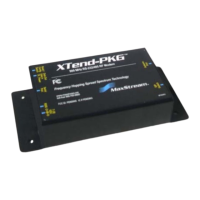9XTend-PKG-U™ USB RF Modem User’s Guide
52
4.3.2. Polling Mode (Acknowledged)
NOTE: Polling Mode (Acknowledged) and Polling Mode (Basic) (see “Polling Mode (Basic)” on
page 49) operate in the same way. The only difference between the two modes is in their means of
achieving reliable delivery of data. In Polling Mode (Acknowledged), reliable delivery is achieved
using retries and acknowledgements.
Attributes:Utilizes high percentage of available network bandwidth
Eliminates collisions
Works with reliable delivery (RR or MT parameters)
Supports binary data transfers
Base modem requests packets from remote modem by polling a sequential
range of addresses
Base modem is configured to specify the range of addresses being polled
Uses inter-character delay to create RF packet lengths aligned with protocol
packet lengths up to 2048 bytes long.
Required Parameter Values (Base): MD (RF Mode) = 3, PB (Polling Begin Address), PE (Polling
End Address)
Required Parameter Values (Remote): MD (RF Mode) = 4
Related Commands: Networking (RR, PD, DT, MY, AM)
Constraints: The minimum time interval between polling cycles is configurable. However, if the
remote modems cannot all be processed within that time interval, the polling cycle is ineffective
(i.e. it will impose no additional delay). In order to ensure a pause between polling cycles, PD
must be set to a value which is large enough to accommodate the pause.
Recommended Use: Use for point-to-multipoint applications that require Reliable Delivery of
data. Use this mode when it is critical that a base modem be able to discern data coming from
multiple modems.
Theory of Operation
A ‘Polling Base’ modem will cycle through a sequential range of addresses. The ‘Polling Base’ will
poll each ‘Polling Remote’ modem, wait for a response, then poll the next remote address in the
sequence. Each ‘Polling Remote’ will respond by sending the data from its DI (Data In) buffer fol-
lowing the RB (Packetization Threshold) & RO (Packetization Timeout) parameters. When there is
no eligible data to send, the ‘Polling Remote’ will not respond. The ‘Polling Base’ will poll the next
address in the polling sequence after a short delay.
Polling Base Configuration:
Polling Remote Configuration:
Set the MD (RF Mode) parameter (MD = 3).
Set MY (Source Address) parameter (MY = 0).
Set the sequential range of Polling Addresses using the PB (Polling Begin Address) and PE
(Polling End Address) parameters.
(Optional) Enable Acknowledged Reliable Delivery (RR >= 0). Note: Basic Reliable Delivery is
also supported. Refer to the ‘Polling Mode - Basic section for more information.
(Optional) Use the PD (Minimum Polling Delay) command to configure a delay between polls to
slow down system (if needed).
(Optional) Enable API Mode to address remotes within polling range on a packet-by-packet
basis.
Set the MD (RF Mode) parameter (MD = 4).
Configure sequential source addresses for all remote modems using the MY (Source Address)
command.
Set the DT (Destination Address) parameter to point to ‘Polling Base’ (DT = 0x0000).
(Optional) Enable Acknowledged Reliable Delivery (RR >= 0). Note: Basic Reliable Delivery is
also supported. Refer to the ‘Polling Mode - Basic section for more information.

